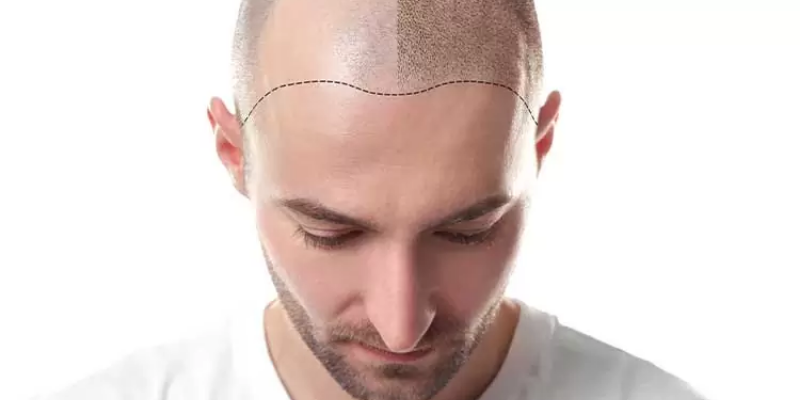Hair Transplant
Hair transplant is a healthy and long-term therapy for thinning and balding in those who have a hair loss problem. Hair transplant is the minimally invasive surgical method of transferring normal hair follicles to regions in which the hair follicle is no longer involved and baldness has occurred. A hair transplant adds hair to an area. Hair transplantation has meticulously planned and carried out on an individual basis. Hair follicles resistive to losing harvest in the person’s nape region and implanted into the channels established in the thinned or entirely losing areas during the hair transplantation procedure.
How Effective Is Hair Transplant?
- Hair transplantation is a treatment for thickening or replacing hair in areas of the head that are balding or thinning. We transplanted hair from thicker areas of the forehead or other regions of the body to thinning or boldness areas of the scalp.
- According to Trusted Source, hair loss impacts roughly 65% of men and 55% of women around the world. To address this, many people turn to over-the-counter medications, particularly topical therapies like minoxidil (Rogaine).
- Hair transplantation is another option for restoration. In the initial transplanting in Japanese in 1939, we used single scalp hairs. Doctors came up with the “plug” operation in the following decades. In this treatment, we implanted large tufts of hair.
- As time went on, doctors used micro- and tiny grafts to lessen the look of transplanted hair on the scalp.
Is It True That Hair Transplant is Effective?
In most circumstances, cosmetic procedures are more successful than over-the-counter hair restoration products. There are a few factors to consider, nevertheless:
individuals with dormant hair follicles sacs deeper inside the skin that used to retain hair but no longer do may have a lower success rate with transplantation, but a 2017 study found that plasma treatment can help up to 76% of transplanted hairs come back completely.
- In three to four months, anywhere from 15% to 80% of the hair that has transplant will have fully grown back.
- Implanted hair will thin over time, just like natural hair.
Is Hair Transplant Effective in All Cases?
Hair transplantation does not always work. They’re primarily utilized to restore hair if it’s losing or thinning, or if we have shed it due to a back injury.
Since most beauty treatments work with your existing hair, they aren’t as effective for people who have:
Traumas on the scalp have resulted from scalp injuries.
Hair loss and baldness are common side effects of other medicines and radiotherapy.
How Much Do Hair Transplants Cost?
The cost of a hair transplant varies widely from person to person. Before we discuss the cause for it, we must first discuss hair transplant procedures. It is a difficult surgical procedure. As a result, the cost of hair transplantation varies depending on the procedure you select.
The final cost may be decided by the following factors:
- Local specialists who are available and have past knowledge about the surgical technique you’ve chosen.
- The total bill could include the cost of aftercare procedures.
- The transplantation’s range
- health insurance does not cover Hair transplantations since they are aesthetic procedures.
What Is the Hair Transplant Operation?
- A hair transplant is a procedure that takes your existing hair and transplants it to a portion of your head where you don’t have any. It’s usually taken from the nape of the neck and head, although it can originate from anywhere on your head.
- Your doctor cleans the region where the hair will extract and numbs it with a local anesthetic before starting the transplant. You can even take medicine if you want to sleep through the treatment.
- We can do Hair restoration in two methods. Your doctor will use one of these. The FUE and FUT procedures are as follows.
Follicular Unit Transplantation (FUT)
- Follicular unit strip operation, or FUSS, is another name for FUT. After these stages, your surgeon uses a FUT procedure:
- With a blade, the operator delicately cuts a portion of your scalp from the back of your neck or head. The strip is usually 6 to 10 inches long, although it can extend above ear to ear.
- Stitches are used to close the incision left by the removal of the scalp.
- Your doctor and their assistants use a knife to cut the hair strips into smaller pieces. They might be able to split the chunk into as many as two thousand grafts. In some of these transplants, only one hair may be present.
Hair Transplantation Operation Steps
- The doctor makes a needle or a blade to make tiny holes in your head where hair will grow.
- The doctor has placed hairs from the head excision into the perforated holes. We know this operation as grafting.
- We then covered The operation wounds with gauze or bandages.
- How many grafts you get is based on the following factors: • What type of hair do you have?
- The size of the transplanted area, the hair quality (including density), and the hair color
Follicular Unit Extraction
FUE is one of the most popular hair transplant techniques nowadays. This is due to the fact that it is more contemporary. Furthermore, hair transplantation using the FUE technique, which results in a natural-looking result, permits you to keep your regrown hair for the rest of your life.
To do a FUE operation, your surgeon will follow these steps:
- The surgeon shaves the hair on the back of your neck and head, then inserts tiny holes in your scalp, similarly to a FUT procedure, and grafts hair cells into the spaces.
- the surgeon then harvested from the scalp skin Single follicles. There will be a small mark on each follicle where it has take.
- They then treat the surgical site with gauze or bandages.
Hair Transplantation Side Effects
The most common symptom is scarring, which no surgery can totally eradicate.
- Here are some additional potential negative consequences:
- There is blood and numbness around the surgical incisions.
- There may be an infected crusty or pus leak around the operation sites.
- If your hair is still balding, visible hair areas that don’t match the surrounding hair or are very weak will continue losing hair.
an infection of the hair follicles (folliculitis) causes •
In General, How Much is s Hair Transplant?

“How much is s hair transplant?” can range in price depending on the amount of work needed and the technique used. It is important to do research and consult with a doctor before making any decisions concerning hair transplant surgery. They will be able to provide you with an accurate estimate of what it will cost, as well as discuss all of the potential risks associated with a hair transplant procedure. Ultimately, it is up to you and your doctor to determine if a hair transplant is right for you.

Be sure to ask your hair transplant doctor about what techniques might work best for your specific case so that you can get the most out of your hair transplant treatment plan. Additionally, there are many financing options available related to “how much is s hair transplant?” for those who need assistance in covering the costs associated with a hair transplant like personal loans or special healthcare credit cards that can help make it more affordable. It is also recommended that potential patients research their options carefully before making their final decision about undergoing a hair transplant procedure. The internet is an excellent source of information where people can read reviews and learn more about different doctors and clinics.


